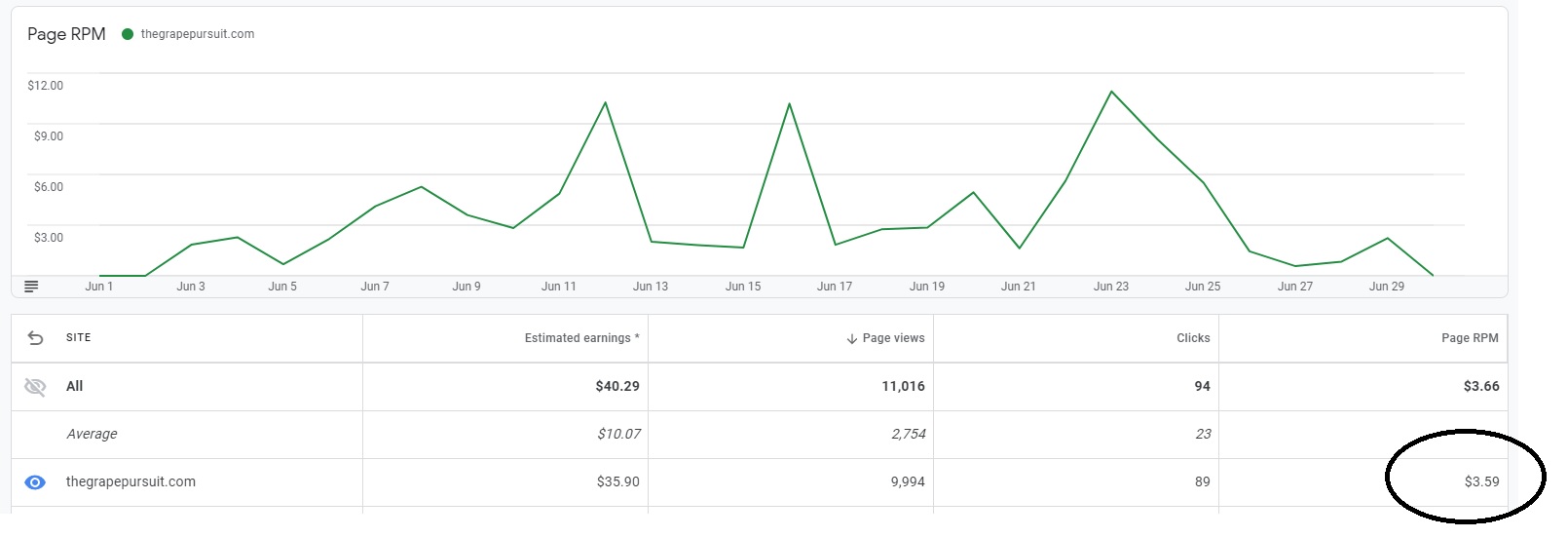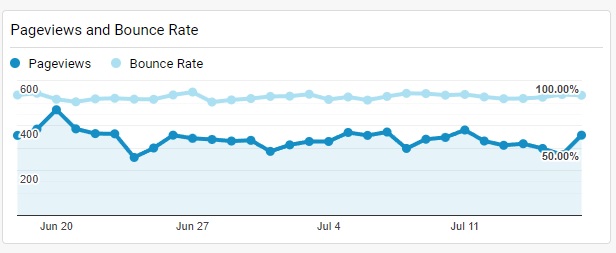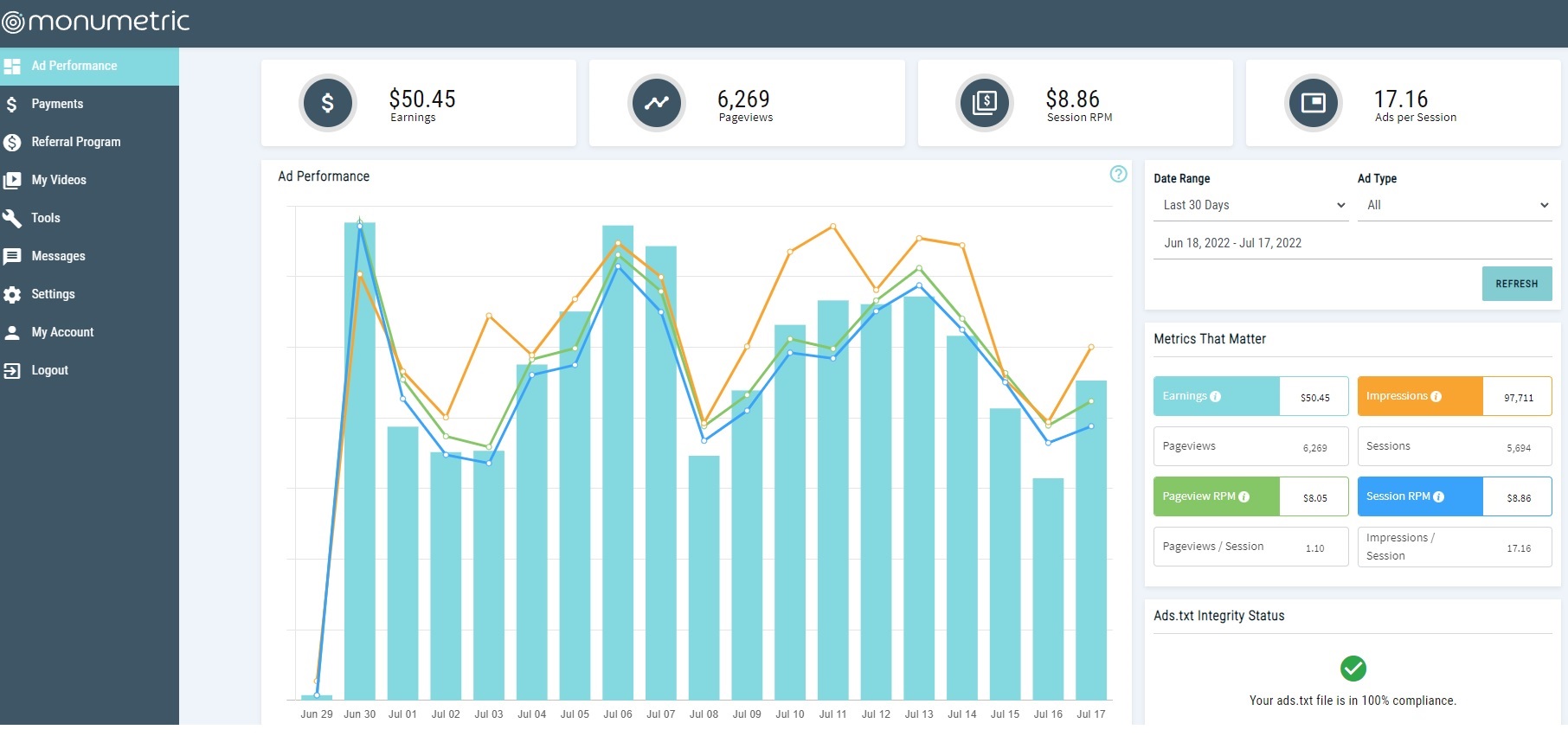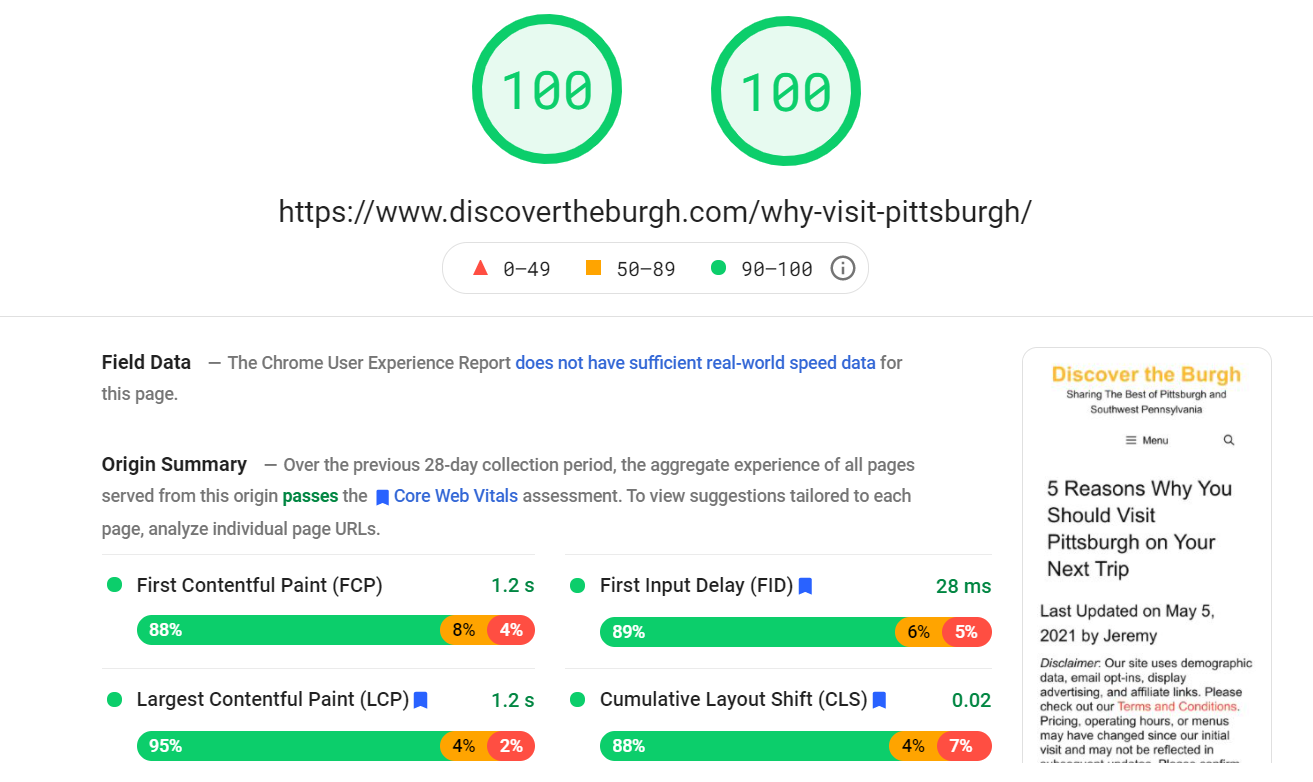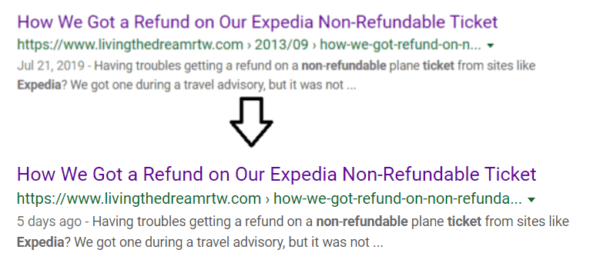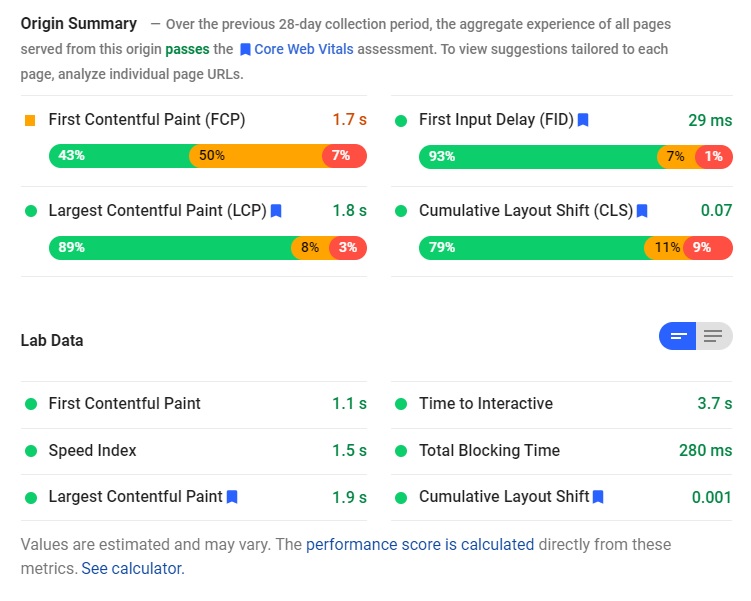Published by Jeremy. Last Updated on June 19, 2024.
Disclaimer: This Week in Blogging uses demographic data, email opt-ins, and affiliate links to operate this site. Please review our Terms and Conditions and Privacy Policy.
When my wine blog, The Grape Pursuit, started to grow, I was hesitant to monetize it too soon. Partly because I didn't have to (my other sites earn enough revenue for me daily), but also because I was holding out for when I qualified for a premium ad network, like Monumetric or Mediavine, in order to make any user experience hit worthwhile.
But for the sake of understanding the state of the advertising market, we decided to put together a little test and turned on AdSense just a little bit before we qualified for Monumetric to see how the two networks compared.
So, what were the results of our AdSense vs Monumetric study? Read on.
Note: RPMs as discussed in this article are based on a page view basis to be in line with AdSense's reporting structure. Some networks report session and page view RPMs, which may be confusing if not clarified upfront.
Upfront Site Metrics and Demographics
Before sharing the results of this test, it is worth noting The Grape Pursuit's reader demographics. Audience location, primary language, and other demographics can greatly impact your ability to get on premium ad networks and your earning potential outright.
The Grape Pursuit is read in English 94% of the time, and approximately 80% of our readers were from the USA, 3.5% from the UK, 2.7% from Canada, and 1.7% from Australia. 65% of our traffic is on mobile, 32% on desktop, and 3% on tablet. 81% of our traffic comes from search, 11% “direct”, and < 2% each on our RSS feed and other search engines like Bing or Yahoo.
Unfortunately, we cannot make blanket statements on how your site would perform with different metrics. But if your site was set up virtually identically to ours in every respect (topic, article length, ad quantities, etc.) with the only difference being your audience location split, we would expect sites with higher USA-based audiences to have higher RPMs while sites with more international readers would likely have lower RPMs.
That is truly all we can say with some degree of confidence. So while it is easy for us to compare one site across two networks, it is hard to project what you may see for your own sites. Your mileage will indeed vary here.
AdSense Is Better Than Nothing (Barely)
If we want to talk about the bottom-of-the-barrel ad networks, it is AdSense- Google's own ad network. We could come up with many theories as to why this one is not great, but it really speaks volumes when established bloggers simply say “wait until you qualify for something better”.
The real reason for this is simply that AdSense rates tend to be pretty terrible. Unless you have a site that receives high CPC ads (which is possible for some lucky content creators in very focused niches whose advertisers will pay insane money), average page view RPMs for us on AdSense have been < $5 for just about every site we've ever tested. We had some days as high as $10 RPM on our wine blog, some days as low as $1 RPM, and the 30-day average was just about $3.50. Throw in the fact that the network has a $100 minimum payout, and at our average RPM you'd need to receive around 30,000 page views to even get a payment.
Doing some quick extrapolation on that, if you are below 1,000 page views per month, you may only get one payment every two or even three years (hopefully you'll grow significantly over that time to make this faster, but you can see how terrible it is). If you get 10,000 page views per month, you may get one payment every two or three months if you're lucky. I even had $55 sitting in my AdSense account from when I bailed on them on my travel sites that sat in the account for over five years because I wasn't earning. That being said, AdSense does pay out roughly NET 25 after the end of a month once you hit an account balance of $100, so if you regularly make $100/month you will get paid faster than Monumetric.
Yes, I happily abandoned that money as soon as I qualified for a better ad network and I'd do it again in a heartbeat even now. Getting paid fast is nice, but getting paid more is better.
So while I am not surprised to find ad rates on AdSense to still be pretty bad, I have to admit even I thought it'd be better than it was from when I used it last. So sign me up to the chorus of bloggers who say put your effort into growing your traffic to qualify for a better ad network. However, AdSense is also better than nothing, and who knows you may get lucky with some CPC spikes to get a payout faster- I just wouldn't hold my breath on that unless your niche is very, very focused.
From the speed side of things, we've read many reports on how AdSense ads can slow your site down if not added correctly. While it seems like Google has improved some scripts over the years, we went straight to manually placing ads via Ad Inserter Pro to take advantage of the lazy load function the premium plugin offers. It is a steep learning curve to go this route, and perhaps minimized the total number of ads we showed over the automatic insertion option, but doing this ensured we saw zero speed or performance impacts on our site (< 1-second load, 100/100 PSI scores). So if you notice speed concerns on AdSense, you may need to get creative on how you implement your ads as the backend tools are sparse.
Finally, one perk of AdSense that should also be discussed here is that they simply accept practically everyone. Premium ad networks often have many rules about readership demographics, traffic levels, etc. that may cause some bloggers to not be able to apply even if hitting the minimum traffic figure. As such, AdSense is pretty good for many bloggers simply because other options are not available at all.
Monumetric is a Great Option at 10k Monthly Page Views
For those who have crossed the 10,000 monthly pageview threshold, Monumetric is the network we would consider. This premium ad network has many of the bells and whistles of the highest premium networks (Mediavine, Raptive) but offers a lower barrier for entry at, admittedly, lower RPMs.
One of the things I really found to be nice about this one is that you are assigned a programmer to help onboard you and get ads on your site. So in AdSense where you are taking a DIY approach, and may not be fully optimized around ads, you have someone from Monumetric here helping you every step of the way.
On the plus side, this means you can tell them which ads you would like turned off and they will do it right away (insofar as you're meeting minimum ad requirements and don't turn off some mandatory slots- most premium networks have terms like these). On the downside, if your site is also under 80,000 monthly pageviews they charge a one-time, $99 fee for this service which is not negotiable. All things being equal, I happily paid this because the fee pays itself off rather quickly.
Still, on my very first full day on Monumetric, my site was sitting at $8 RPM. For full disclosure, this was also on July 1st, the start of Q3, where ad rates typically drop 30-40% overnight before recovering a few weeks later. As services like these generally take around 30 days to optimize, and longer for seasonal variation to be seen, it is worth noting that in less than a week my site jumped to nearly $10 RPM, and by the end of the first month it was sitting at about $10 RPM on average. I'll admit that part of this was simply due to showing more ads than AdSense outright, but this was a solid jump beyond that.
Suffice it to say, at 10,000 page views per month, it was nice to go from making about $35/month on AdSense to $100/month on Monumetric- a nice little supplement for our wine budget all the same.
From the speed side of things, we let Monumetric insert all ads using their proprietary program. At first, they turned on ads above-the-fold, which can influence Page Speed Insights scores like LCP and CLS, but they removed these at our request to ensure we had no above-the-fold ads displaying. Once this was done, we saw no impact on our site performance whatsoever as the ads appeared to be properly lazy-loaded (we still maintained < 1-second load, roughly 100/100 PSI scores). As such, I have zero speed concerns with this network after turning off above-the-fold ads.
Likewise, it is also worth noting that the dashboard on Monumetric is a bit sparse. AdSense provides significantly more depth of information to dive into for data analysis whereas Monumetric is somewhat limited (possibly limited to those in the lowest Propel tier). This is a minor concern because I'd rather have more money than data, but it is unfortunate all the same.
For payment, Monumetric pays on NET 60 terms after the close of the month. So all of your earnings from January will be paid in April, your earnings from February will be paid in May, and so on. The network does not have a minimum payout like on AdSense, but if you were receiving payouts of a minimum of $100/month on AdSense prior to joining Monumetric, keep in mind you're going to have a gap in payments for a month or so. This is not unusual for premium ad networks as most pay roughly NET 60 terms as it takes time for all the ad buyers to settle payments whereas Google can process payments on their end slightly faster.
- Want to read more about Monumetric? Our Monumetric review goes into a deeper dive than the above!
Monumetric is the Clear Winner In Virtually All Cases
When it comes down to it, you'll get no argument from us- Monumetric runs circles around AdSense in just about every case out there.
Yes, not all bloggers will qualify. And yes, AdSense has a CPC benefit that could benefit some bloggers in very niche topics. But that being said, unless your audience is primarily outside of the USA or with non-English speaking readers (such that you don't qualify for premium ad networks at all), odds are very good you're going to see an RPM increase with Monumetric.
At first, I thought Monumetric's RPMs may have been simply a function of ad volume. There is no doubt that I was showing significantly more ads than I was on AdSense (more ads in total but better fill rates for more ads shown), but I also had turned on video ads as well- so naturally, my RPMs had to go up. But after stabilizing over the course of a month, the increase in RPMs seemed greater than the proportional number of ads shown on my site, suggesting Monumetric does command better-paying ads outright as well- not by much, but enough.
Whatever the case may be, at 10,000 page views per month my wine blog went from earning about $35/month on AdSense to $100/month on Monumetric, without any speed impact, and for that, I am happy to have made the switch.
Did you make the switch from AdSense to Monumetric? What kind of changes did you see? Comment below to share your figures and the niche you are in as well!
Looking to apply for Monumetric? Click here. Note that we are Monumetric affiliates and may receive a commission upon referral. As always, all opinions are our own.
Join This Week in Blogging Today
Join This Week in Blogging to receive our newsletter with blogging news, expert tips and advice, product reviews, giveaways, and more. New editions each Tuesday!
Can't wait til Tuesday? Check out our Latest Edition here!
Upgrade Your Blog to Improve Performance
Check out more of our favorite blogging products and services we use to run our sites at the previous link!
How to Build a Better Blog
Looking for advice on how to improve your blog? We've got a number of articles around site optimization, SEO, and more that you may find valuable. Check out some of the following!

